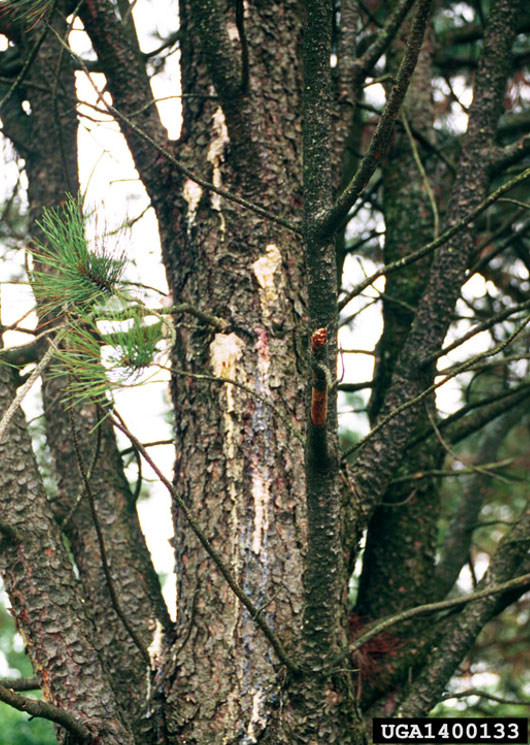Issue 14, August 29, 2018
Zimmerman Pine Moth
Zimmerman pine moth (Dioryctria zimmermani) is a borer that injures tree trunks and scaffold branches. These insects commonly feed on Austrian, red and Scotch pines in Illinois, causing dieback in branches and twigs. Zimmerman pine moth injury can be identified on the trunk as crusted areas of white pitch 1 to 2 inches in diameter or white cones of pitch that are about 1 inch in diameter. Terminal leaders that are heavily infested may also begin to bend downward like a hook.

Linda Haugen, USDA Forest Service, Bugwood.org
Adult moths emerge from the trees in late summer, usually mid-July in southern Illinois and mid-August in northern Illinois. At this time they mate and deposit eggs in crevices or wounds in the surface of the bark and at terminal buds. These eggs will hatch about 10 days later, usually in early-August in southern Illinois and late-August in northern Illinois. The young larvae will begin to move across and feed on the surface of the bark for several weeks. When the caterpillars mature, they will begin to spin cocoons where they overwinter. In the spring, the larvae will become active again, moving across the bark for several days before boring into the tree.
While these insects can be difficult to control after they bore into a tree or while they overwinter, the larvae moving across the surface of the tree are susceptible to chemical controls are can be targeted. The caterpillars range from 1/16 of an inch long when they hatch to 3/4 of an inch long when they are mature. They have tan or green bodies with small dark spots and can be found at the base of terminal buds or in the grooves of the bark.
Because the larvae are available on the surface of the trunk and major branches, spray applications to these locations, this time of year, can be effective in controlling Zimmerman pine moth. Pyrethroid insecticides such as bifenthrin (Onyx), cyfluthrin (Tempo), permethrin (Astro), or other labeled insecticide to control Zimmerman pine moth can be used. These pests usually only attack the trunk in trees under 8 inches in diameter. In these smaller trees, the lower 10 to 12 feet can be treated. In larger trees, the branches are more likely to be attacked and can be treated. (Sarah Hughson)
Author:
Sarah Hughson